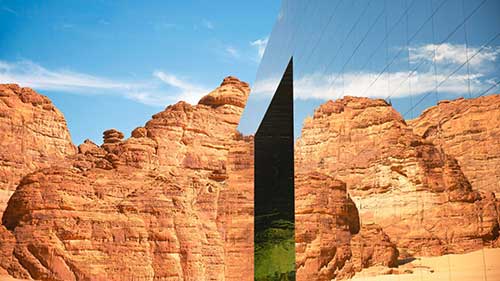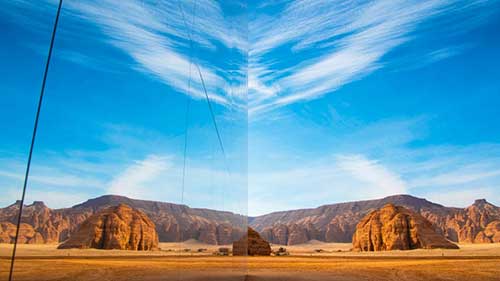The Maraya Concert Hall is the largest mirrored building in the world, built by the Royal Commission for Al Ula (RCU) in the desert in the Ashar Valley, Saudi Arabia. With ancient wind-sculpted sandstone mountains reflected along its length, its structure appears to disappear and then reappear in the landscape.
The concert hall is also a center for artistic and cultural events in AlUla. The building has an ultra-modern structure, with 9,740 m² of mirrored glass in a place that no one would expect to find a work of this size. Although ‘Maraya’ means ‘mirrors’ in Arabic, this is no ordinary mirrored glass, it is a formulation specially developed by Guardian Glass, in just three months, for this work.

Public tender
Nabil El Ahmar, then manager of Mega Projects and Strategic Partnerships at Guardian Glass, was first invited to look at the project after an attempt at a mirror solution, proposed by another company, failed. The exterior was covered in gigantic sheets of metal, reflecting a distorted version of the environment.
A public competition was then announced to choose the best solution. It soon became clear that the competing proposals were all variations of highly reflective silver glass. “The designer wanted a real mirror”, explains Nabil, “with sand and mountains, a more visible building would be an intrusion on the environment”. In this scenario, only Guardian Glass accepted the challenge of creating a new exterior mirrored glass capable of withstanding such extreme conditions.
However, winning the contract was the easy part. From this point, the real challenge began. Covering a 500-seat concert hall in the middle of a vast desert with giant mirrors was a technical and logistical puzzle in itself.

Term
But the team had another obstacle to overcome: the deadline. The concert season would begin in December, with just three months to go, and artists were already booked and tickets sold. “Not delivering the mirrors on time would have been catastrophic for everyone,” says Nabil.
He remembers that ingenuity and perseverance paid off. “We had to develop solutions for the unique needs of the Maraya Concert Hall, adds Jasmin Hodzic, Guardian Glass Marketing Director for Africa and the Middle East.
New mirror
Developers have always avoided using traditional exterior mirrors. One of the reasons is durability, as intense sunlight or humidity can cause oxidation, distortion and discoloration of the plates.
To address these issues, a new mirror was developed, based on an indoor mirror from Guardian Glass, the UltraMirror, a highly durable product but with a special protective coating. “The new product had to resist some of the most aggressive elements on the planet, and one of the most striking characteristics of copper is its resistance to corrosion,” says Nabil.

Tempered glass
This also required a new logistical process. Mirror raw material is typically produced in standard raw sheets, using annealed glass, and then sent to a processor for cutting. However, due to the extreme temperatures that the Maraya’s exterior would be exposed to, the glass had to be tempered and therefore could not be cut after being coated without the risk of breaking. Guardian resolved this by sending the raw annealed glass to the processor. The latter then sent the raw glass, cut to size and heat treated, back to Guardian, who applied the protective coating.
Guinness
Opened in 2019, the Maraya Concert Hall is listed in the Guinness World Records as the largest mirrored building ever built, and won the Architizer A+ Awards 2020 in the Architecture and Glass category. Its architecture also contributed to increasing fascination with the nearby archaeological site of Al-Hijr – the first site in Saudi Arabia certified as a World Heritage Site.
Datasheet
Client: Royal Commission, Al Ula
Events Agency: MMG KSA
Project management and creation: Black Engineering Dwc-Llc. (Massimo Fogliati, Fabio Pavanetto)
Architecture and Design: Gioforma Architects Designers and Artists, Milan (Florian Boje, Cristiana Picco, Claudio Santucci)
General Engineering: Gap progetti
The Maraya Concert Hall is the largest mirrored building in the world, built by the Royal Commission for Al Ula (RCU) in the desert in the Ashar Valley, Saudi Arabia. With ancient wind-sculpted sandstone mountains reflected along its length, its structure appears to disappear and then reappear in the landscape.
The concert hall is also a center for artistic and cultural events in AlUla. The building has an ultra-modern structure, with 9,740 m² of mirrored glass in a place that no one would expect to find a work of this size. Although ‘Maraya’ means ‘mirrors’ in Arabic, this is no ordinary mirrored glass, it is a formulation specially developed by Guardian Glass, in just three months, for this work.

Public tender
Nabil El Ahmar, then manager of Mega Projects and Strategic Partnerships at Guardian Glass, was first invited to look at the project after an attempt at a mirror solution, proposed by another company, failed. The exterior was covered in gigantic sheets of metal, reflecting a distorted version of the environment.
A public competition was then announced to choose the best solution. It soon became clear that the competing proposals were all variations of highly reflective silver glass. “The designer wanted a real mirror”, explains Nabil, “with sand and mountains, a more visible building would be an intrusion on the environment”. In this scenario, only Guardian Glass accepted the challenge of creating a new exterior mirrored glass capable of withstanding such extreme conditions.
However, winning the contract was the easy part. From this point, the real challenge began. Covering a 500-seat concert hall in the middle of a vast desert with giant mirrors was a technical and logistical puzzle in itself.

Term
But the team had another obstacle to overcome: the deadline. The concert season would begin in December, with just three months to go, and artists were already booked and tickets sold. “Not delivering the mirrors on time would have been catastrophic for everyone,” says Nabil.
He remembers that ingenuity and perseverance paid off. “We had to develop solutions for the unique needs of the Maraya Concert Hall, adds Jasmin Hodzic, Guardian Glass Marketing Director for Africa and the Middle East.
New mirror
Developers have always avoided using traditional exterior mirrors. One of the reasons is durability, as intense sunlight or humidity can cause oxidation, distortion and discoloration of the plates.
To address these issues, a new mirror was developed, based on an indoor mirror from Guardian Glass, the UltraMirror, a highly durable product but with a special protective coating. “The new product had to resist some of the most aggressive elements on the planet, and one of the most striking characteristics of copper is its resistance to corrosion,” says Nabil.

Tempered glass
This also required a new logistical process. Mirror raw material is typically produced in standard raw sheets, using annealed glass, and then sent to a processor for cutting. However, due to the extreme temperatures that the Maraya’s exterior would be exposed to, the glass had to be tempered and therefore could not be cut after being coated without the risk of breaking. Guardian resolved this by sending the raw annealed glass to the processor. The latter then sent the raw glass, cut to size and heat treated, back to Guardian, who applied the protective coating.
Guinness
Opened in 2019, the Maraya Concert Hall is listed in the Guinness World Records as the largest mirrored building ever built, and won the Architizer A+ Awards 2020 in the Architecture and Glass category. Its architecture also contributed to increasing fascination with the nearby archaeological site of Al-Hijr – the first site in Saudi Arabia certified as a World Heritage Site.
Datasheet
Client: Royal Commission, Al Ula
Events Agency: MMG KSA
Project management and creation: Black Engineering Dwc-Llc. (Massimo Fogliati, Fabio Pavanetto)
Architecture and Design: Gioforma Architects Designers and Artists, Milan (Florian Boje, Cristiana Picco, Claudio Santucci)
General Engineering: Gap progetti






